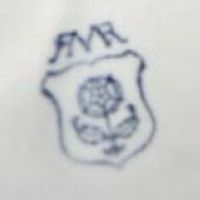
Image 010233-01-01
Blue underglaze stylized "RMR" above shield with rose. Registered at the Landgericht Sachsen-Coburg-Gotha on October 15th 1894.
Over time I received various mails regarding the location of the main factory of Max Roesler and subsequent claims that the state of origin actually was Thuringia. That is not correct as Rodach is located in the region of Coburg which once was an independent free state. Historic fact is that the city of Coburg until 1918 was the residence of the Dukes of Sachsen-Coburg. Monarchy in that region ended on November 14th 1918 after Duke Carl Eduard retired and in the following 1919 plebiscite 88% of all Germans decided that the free state of Coburg should not merge with Thuringia but should rather be integrated into Bavaria and thus the city of Coburg and the region of the same name officially became part of Bavaria (in the subregion of Upper Franconia) on July 1st 1920. And so this factory is of course found in the Bavaria group; also, the town nowadays is known as Bad Rodach as it officially advanced to a Spa in the year 1981.
Max Roesler was the son of Otto and Tina Roesler (née Tennecker), actors from the city of Dresden which were employed by the Royal Theater in Coburg. Roesler in 1858 started to study chemistry in Dresden but decided to continue his studies in Munich two years later, successfully finishing in 1862. His first employment saw him as second chemist of a chemical plant in the town of Blasewitz, from 1864 onwards he worked as chemist and technical supervisor for a chemical plant in Elbogen near Karlsbad. In 1868 he married Theodora Kemmler (*1839, †1925) and together they had four children, two sons (Heinz and Max) and two daughters (Elsa and Paula).
Looking for a challenge Max Roesler in early 1873 worked as technical manager of the Steingutfabrik Franz Anton Mehlem in Bonn only to change over to the Mosaikplattenfabrik Sinzig nearly a year later. That occupation was extremely short-lived as he already moved on in the summer of 1874 after having being offered the position of technical and commercial manager of the Wächtersbacher Steingutfabrik in the town of Schlierbach. Only four years later he became director of the factory and his ideas greatly influenced business during his next twelve years in office. One of the pillars of his success was his strong interest in social concerns of workers and so he for example founded a factory savings bank which helped the workers to purchase own housing in 1877. A manual labor school for young girls as well as a workers music association were founded shortly afterwards, followed by a collegium for disciplinary matters in 1884 and a company newspaper (the Schlierbacher Fabrikbote) in 1888. In 1890 Roesler decided to work for the porcelain factory of Springer & Co. in Elbogen (Bohemia) but already in autumn 1893 he and his family moved to Rodach near Coburg.
The company was officialy registered on the 24th of July 1894 in the town of Rodach, located between the Bavarian town of Coburg and the Thuringian town of Suhl, and the factory was constructed directly next to the railroad between Rodach and Suhl which had only been opened shortly before (July 1st 1892). The trade register entry states that it was set up for 'fabrication, decoration and sales of porcelain, stoneware and other fine earthenware' and the symbol of a hedge rose - part of the family crest derived from the name Roesler - was chosen as company mark. During January 1895 the first sculptural samples were lined up for design- and product registration but it still took until January 1st 1896 before actual production started as the company still had to employ enough skilled workers. In the year 1900 the Roesler business already owned and produced about 1,000 different registered designs. On December 24th of that year Roesler was awarded the title 'councillor of commerce' by the hereditary prince of Sachsen-Coburg and Gotha Ernst zu Hohenlohe-Langenburg himself and the 22nd of July 1908 saw Roesler awarded the Knight's Cross 1st Class of the Ernestine House Order, presented by Duke Carl Eduard.
Just as unexpected as the death of his second son Max who had died 1897 at the age of merely 15 came the second blow for Roesler as his first son Heinz died at the age of 32 in 1909 and having lost his designated successor Roesler decided to change the company into a corporation early in 1910. His idea was that only employees and his personal friends should become shareholders and as all shares had a face value of 1,000 German Marks he installed an option so that two employees could purchase one share together; the statutes also declared that 25 percent of the net profit should be split between employees.
The same year Heinrich Pudor mentioned the company of Max Roesler in his article 'Kunstkeramische Werkstätten', praising the individuality and originality of the products and the artistic company profile. At that time the factory employed a total of 350 people, at the end of 1912 the company had 33 salaried employees and a workforce of 372 (270 men and 102 women) as well as 32 young apprentices. Sixty percent of the annual turnover was made on the German market, the other fourty percent came from international trading with Russia, Austria-Hungaria, France, Denmark, Belgium, Italy, Spain, Switzerland, the Netherlands, Sweden, England, Australia, Central- and South America and the United States. Part of the success was based on the fact that quite a lot of patterns and designs came from the artist Franz Josef Mayer.
Production was stopped in August 1914 with the outbreak of the First World War as nearly all orders were cancelled and the railroad-based transport were needed for soldiers and military equipment. This got better in the year 1915 as production on a small scale was restarted. But from the 300 males working for Max Roesler around 150 had been forced into military service. Directly after the war things did not look good at all and so Roesler in July 1919 sold all his shares to the banking house run by the Arnold brothers (Bankhaus Gebrüder Arnold) in Dresden, himself also retiring from the board. Shortly afterwards things began to look better as orders were pouring in and the maximum production capacity was soon reached. Max Roesler received an honorary doctorate from the technical college in Munich in 1920 but died at the age of 82 on June 2nd 1922; he was buried at the Rodach cemetery. A not vital but nonetheless interesting fact is that the Bankhaus Gebrüder Arnold was also main shareholder of the Porzellanfabrik C. Tielsch & Co. AG company in Altwasser (Silesia).
The new owners in the year 1923 took their chance of acquiring the Großherzogliche Keramische Manufaktur GmbH in Darmstadt and production there started in 1924 after extensive conversion of the facility which was run as Porzellan- und Feinsteingutfabrik Max Roesler AG, Werk Darmstadt (see there for Darmstadt-specific marks). Following the collapse of US stock market on October 24th 1929, it was obvious that the whole business needed to be restructured and so the subsidiary closed again in 1931.
Never having fully recovered from that blow the Rodach factory in 1938 was finally put up for sale. Through an extensive aryanisation project a Bavarian minister of the interior was able to catch the attention of the Siemens-Schuckert Werke in Berlin who helped the company by using it as a subsidiary for its own production; the Rodach factory still produced earthenware until 1940 but was more and more forced to produce urgently needed porcelain insulators. In March 1943 the Max Roesler AG merged with the Siemens-Schuckertwerke AG, resulting in the Siemens-Schuckertwerke Porzellanfabrik Rodach and the name Max Roesler was erased from the trade register.
For a short period after the Second World War the factory produced earthenware again, but only to fulfil the basic need of the population. During the period from 1956 and 1957 the ceramic production was finally stopped and the whole factory was converted into a plastics processing plant and renamed to Siemens Kunststoffpresswerk Rodach. In the year 1995 the French company Valeo took over the facility from Siemens and started to produce car air conditioning systems there.
All that remains of Max Roesler today except for the collectibles still around is his former residential building which is used as administrative building by the city council of Bad Rodach and of course a street which was named after the businessman that did so much for the town and its workers.
It is sometimes incorrectly claimed (e.g. by author Robert Röntgen) that the business of Max Roesler a one point around 1920 belonged to the Aelteste Volkstedter (Volkstedt, Thuringia). Fact is that the company of Max Roesler, wanting to open a subsidiary in Darmstadt (Hesse), in 1924 purchased the former Großherzogliche Keramische Manufaktur from the Aelteste Volkstedter (which themselves had only just taken over the factory in Februrary 1923).
Some items come with an addition "Entw. Prof. Behrmann", this is a reference towards Professor Adolf Behrmann. Others come with the addition "Entw. Partz" addition, referring to the designer F. Gustav Partz, who worked for the Roesler company from 1921 onwards.

Image 010233-01-01
Blue underglaze stylized "RMR" above shield with rose. Registered at the Landgericht Sachsen-Coburg-Gotha on October 15th 1894.
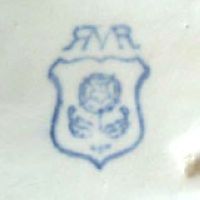
Image 010233-01-02
And another example: blue under glaze stylized "RMR" above shield with a rose.
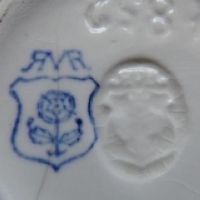
Image 010233-01-03
The first Roesler mark is also frequently found together with the impressed version as shown here.
(Picture: Monika Birkl)
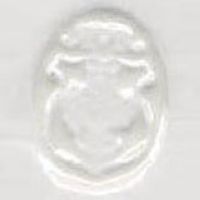
Image 010233-01-04
The impressed version was however mainly used alone and is found with a varying degree of detail.
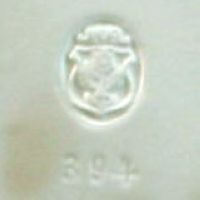
Image 010233-01-05
Another example of the impressed mark, also quite unrecognizeable.
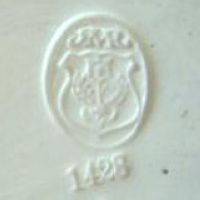
Image 010233-01-06
And this is a good example of what it actually should look like.
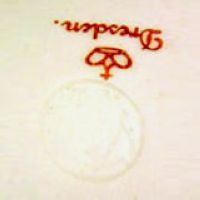
Image 010233-01-07
Here we see the impressed mark on a piece decorated by the Donath & Co. company in Dresden (Saxony).

Image 010233-01-08
Some of the normal marks showed additions like "Germany".
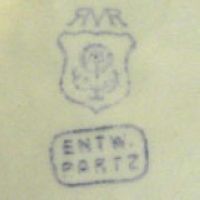
Image 010233-01-09
The normal Roesler mark with "Entw. Partz" addition (see Comment(s) section above).
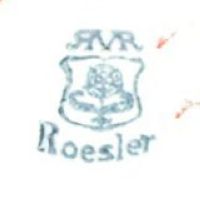
Image 010233-01-10
The standard mark from 1923 onwards carries the addition "Roesler", see also the Max Roesler, Darmstadt versions.
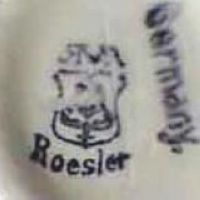
Image 010233-01-11
Same as before, here also with the stamped addition "Germany".
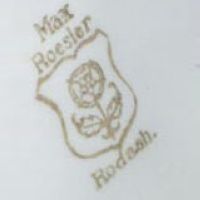
Image 010233-01-12
Blue or gold; registered at the RWZR under №·416·591 on April 1st 1930. Can also be found without "Max".
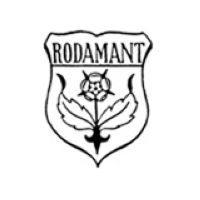
Image 010233-01-13
Used from 1931 onwards on a small number of items only, the standard shield topped by the "Rodamant" trademark.
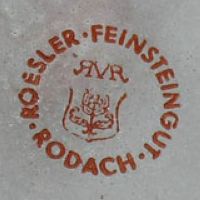
Image 010233-01-14
Used around 1937, standard "RMR" mark encircled by "Roesler Feinsteingut Rodach".
(Picture: David Torreggiani).
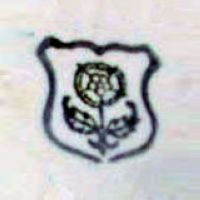
Image 010233-01-15
Rare Roesler mark, found on a (probably) unlicensed Disneyana, a porcelain cup showing the Three Little Pigs.
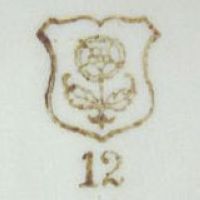
Image 010233-01-16
Same as before, only this time in a reddish brown.
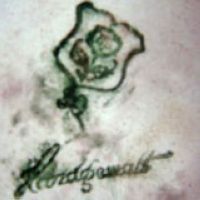
Image 010233-01-17
And one in green just accompanied by script handgemalt.
(Picture: Brenda Ginsberg).
© 2004-2025 C.S.Marshall, all rights reserved